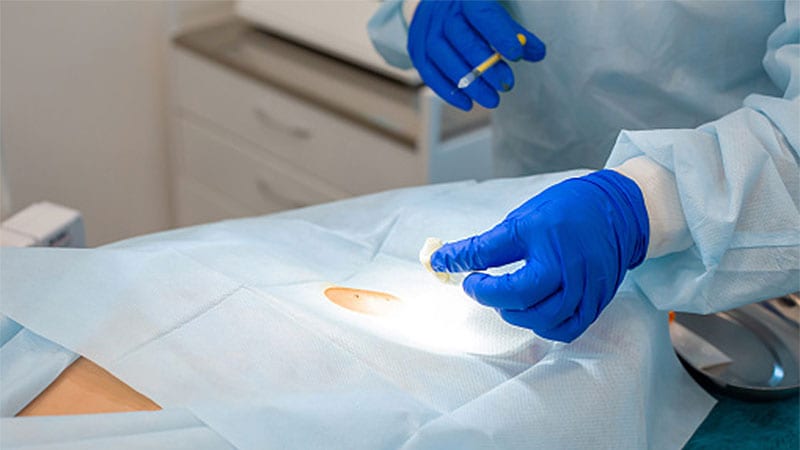Recent Trends in Pediatric Skin Biopsies at UCSF
Core Concepts
Understanding pediatric skin biopsy trends and patterns is crucial for informed medical decision-making in dermatology clinics.
Abstract
- Over 1,000 skin biopsies at UCSF analyzed.
- Common results: compound nevus, pyogenic granuloma, spongiotic dermatitis.
- Fewer biopsies during the first 3 years of the COVID-19 pandemic.
- Importance of pediatric biopsies highlighted.
- Study reviewed 1,196 biopsy specimens from 1,080 patients.
- Most common diagnoses: compound nevus, pyogenic granuloma, spongiotic dermatitis.
- 30 malignant diagnoses identified.
- Decrease in biopsies during the pandemic.
- Different diagnoses pre- and post-pandemic.
- Emphasis on neoplastic conditions in biopsies.
- Complex decision-making process for pediatric biopsies.
- Main goals of pediatric biopsies: diagnosis, management, therapeutic.
- Study conducted by UCSF dermatopathology fellow and colleagues.
Customize Summary
Rewrite with AI
Generate Citations
Translate Source
To Another Language
Generate MindMap
from source content
Visit Source
www.medscape.com
Study Reviews Recent Pediatric Skin Biopsy Trends
Stats
Among more than 1,000 skin biopsies performed over the last 6 years by pediatric dermatologists at UCSF, the three most common biopsy results were compound nevus, pyogenic granuloma, and spongiotic dermatitis.
Fewer biopsies were performed in the first 3 years of the global COVID-19 pandemic than in the previous 3 years.
Half of the patients were female, their mean age was 11.5 years, and they ranged in age from 1 day to 61 years.
Nearly half of biopsies (47%) were performed in patients aged 12-18 years and one-quarter (25.6%) were performed in those aged 6-11 years.
The five most common biopsy results were compound nevus (99 biopsies), pyogenic granuloma (96), spongiotic dermatitis (57), intradermal nevus (53), and pilomatricoma (40).
30 malignant diagnoses in 28 unique patients were identified.
There was a statistically significant decrease in the number of biopsies during the pandemic compared with the 3 years prior to the pandemic (P = .04).
Quotes
"The work is important because very few pediatric patients, relative to adult patients seen in dermatology clinics, have a biopsy done." - Kelly M. Cordoro, MD
"Our data showed that neoplastic conditions were biopsied more often than inflammatory conditions, with an emphasis on lesions that required removal (such as pyogenic granuloma), raised concerns for atypia (nevi), or had implications for systemic management." - Dr. Cordoro
Key Insights Distilled From
by Doug Brunk at www.medscape.com 07-26-2023
http://www.medscape.com/viewarticle/994845
Deeper Inquiries
What are the implications of the decrease in pediatric skin biopsies during the COVID-19 pandemic
The decrease in pediatric skin biopsies during the COVID-19 pandemic has several implications. Firstly, it may indicate a shift in healthcare-seeking behavior among parents or caregivers, possibly due to concerns about exposure to the virus in healthcare settings. This decrease could lead to missed or delayed diagnoses of certain skin conditions in children, potentially impacting their overall health outcomes. Additionally, the reduced number of biopsies may have implications for research and data collection in pediatric dermatology, affecting the understanding of disease trends and treatment outcomes over time.
How can the findings of this study impact the approach to pediatric dermatology care
The findings of this study can significantly impact the approach to pediatric dermatology care by providing insights into the common skin conditions that require biopsy in children. Understanding the most frequent biopsy results, such as compound nevus, pyogenic granuloma, and spongiotic dermatitis, can help dermatologists prioritize their diagnostic and treatment efforts. This knowledge can also guide the development of clinical guidelines for when to consider a biopsy in pediatric patients, leading to more targeted and efficient care delivery. Furthermore, the identification of malignant diagnoses underscores the importance of early detection and appropriate management in pediatric dermatology practice.
How can the decision-making process for pediatric skin biopsies be improved to ensure optimal patient outcomes
To improve the decision-making process for pediatric skin biopsies and ensure optimal patient outcomes, several strategies can be implemented. Firstly, enhancing communication and shared decision-making between healthcare providers, caregivers, and pediatric patients (if age-appropriate) is crucial. This collaborative approach can help in weighing the risks and benefits of a biopsy, considering the age of the child, clinical context, and necessity of the procedure. Additionally, incorporating advanced diagnostic tools, such as dermoscopy and molecular testing, can aid in more accurate and timely diagnoses, reducing the need for unnecessary biopsies. Moreover, ongoing education and training for healthcare professionals in pediatric dermatology can enhance their skills in recognizing skin conditions that warrant biopsy, leading to improved patient care and outcomes.
0
